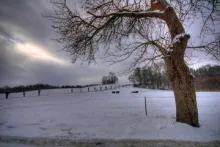When King Winter and the Ice Queen reign over the waters the fishing slows down. What better to do than to get out your camera and snap some pictures of the beautiful landscapes, icy hardship and the rare but well-deserved fish.
|
|
When King Winter and the Ice Queen reign over the waters, the fishing slows down. What better to do than to get out your camera and snap some pictures of the beautiful landscapes, icy hardship and the rare but well-deserved fish?
Anglers in the Baltic area will often spend some days in the cold months in pursuit of sea trout. Sometimes you can run into the most fantastic fishing, but most days are slow and cold. You cannot stay too long in the water, and when it is as coldest, ice will form—both in the water and in the guides of your rod. There is little life in the water and the few fish, which are around, are generally slow and not very active. Sun can stimulate activity, and just a few hours of heat from the low sun can bring about an amazing blooming of critters in the shallow water. When the water is close to freezing, even a couple of degrees increase in temperature will make a big difference.
|
|
|
|
|
|
Once you do engage with Baltic sea trout in the winter they seem to fall in three categories: large, bright ones, large colored ones and small bright ones. The latter can occur in large schools, but the chance of running into one of these flocks is slim. The bigger fish can be found in the deep Baltic—southern Denmark and Sweden and northern Germany. The big fish are fish, which go into the Swedish and other Baltic streams. These fish will stay close to the shore to feed until temperatures rise. Then they move out into the deeper water and out of reach of most anglers. During the cold season you can meet them as fish on their spawning run, as kelts, which have spawned or as silver-bright fish, which have skipped a spawning run and staid in the ocean to feed.
|
|
|
|
But why talk so much about fish, when fishing is as slow as it is? The fact is that the really fantastic and productive trips are rare in the winter, and the rule is that you spend a cold day by the water without many contacts and only rarely actually see a fish.
So why go?
We go because we still like to be by the water, and because we might happen to be lucky. And who can sit in the living room looking out on a nice sunny day, which just plagues you to go fishing? Once you are out there you can enjoy the fantastic snowscapes, the ice formations and hopefully the beauty of a blue sky and a low sun. And don’t remember to bring a camera and take plenty pictures. This page shows what the Baltic area can bring. Your favorite fishing water may offer similar sights.
|
|
|
|
|
|
|
|
|
|
|
|
- Log in to post comments



























Finally, an article
Finally, an article that captures why I like to stand in the Danish icy salt throughout the toughest months. It's not all about catching fish but enjoying the whole experience. No matter what the season, there's plenty to see and do and for me...Winter brings dreams of the coming season.
There's something to marvel at after fishing on a chilly winters day all rounded off with a hot shower, good hearty meal and seeing the smile on my sons face as my cheeks and nose tingle with life!